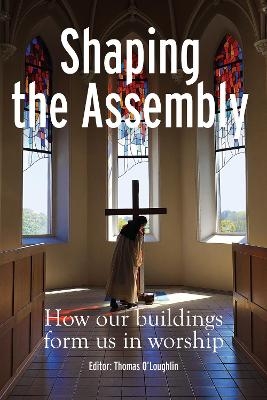
Shaping the Assembly
How our Buildings Form Us in Worship
Seiten
2023
Messenger Publications (Verlag)
978-1-78812-611-3 (ISBN)
Messenger Publications (Verlag)
978-1-78812-611-3 (ISBN)
This book brings together nineteen Christians from around the world to try to answer the question of how space affects us in worship. Some topics covered include the role of light in a religious building, the varying needs of spaces for different liturgies, and how the liturgical renewal begun in Vatican II should continue today.
Space is all around us – and we constantly refer to it. He is taking my space! This place is homely! This room is very impersonal! We need more room! We need to de-clutter! I was lost in the vastness of the hall! I felt locked in and had to go outside!
We also know that how space is arranged affects us: we want ‘round table talks’ and we do not want to be put in the back row! Churchill captured the importance of built space in a couplet: We shape our buildings, then our buildings shape us. And in every society buildings have been used to project power and authority, to regulate society, and to project an image of how that group sees itself.
Strangely, we out do not think about this aspect of space when it comes to liturgy – yet every religion (and every Christian denomination) has used buildings as part of their worship: from Newgrange to classical temples to churches build of steel, concrete and glass. And it was this concern of the Second Vatican Council that led to the changes in the arrangements in Catholic Churches in the 1960s and 70s. But this religious use of space – just as with the changes mandated by Vatican II – are little appreciated or understood.
This book brings together nineteen Christians – liturgists, pastors, architects, artists – from several churches and from around the world who all try to answer the question of how space affects us in worship.
The topics covered include the role of light in a religious building, the need for space to appreciate dance as part of worship, the varying needs of spaces for different liturgies, accounts of how communities have become creative with space, and questions about how the liturgical renewal begun in Vatican II should continue today.
Space is all around us – and we constantly refer to it. He is taking my space! This place is homely! This room is very impersonal! We need more room! We need to de-clutter! I was lost in the vastness of the hall! I felt locked in and had to go outside!
We also know that how space is arranged affects us: we want ‘round table talks’ and we do not want to be put in the back row! Churchill captured the importance of built space in a couplet: We shape our buildings, then our buildings shape us. And in every society buildings have been used to project power and authority, to regulate society, and to project an image of how that group sees itself.
Strangely, we out do not think about this aspect of space when it comes to liturgy – yet every religion (and every Christian denomination) has used buildings as part of their worship: from Newgrange to classical temples to churches build of steel, concrete and glass. And it was this concern of the Second Vatican Council that led to the changes in the arrangements in Catholic Churches in the 1960s and 70s. But this religious use of space – just as with the changes mandated by Vatican II – are little appreciated or understood.
This book brings together nineteen Christians – liturgists, pastors, architects, artists – from several churches and from around the world who all try to answer the question of how space affects us in worship.
The topics covered include the role of light in a religious building, the need for space to appreciate dance as part of worship, the varying needs of spaces for different liturgies, accounts of how communities have become creative with space, and questions about how the liturgical renewal begun in Vatican II should continue today.
Thomas O’Loughlin is a writer, historian and theologian. He has taught and written extensively on different practices and interpretations of Eucharistic celebration leading to inter-church disagreement. He is involved in ecumenical reflections on eucharistic activity and has explored whether a richer understanding of the nature of worship could overcome inherited misunderstandings and divisions among Christians.
| Erscheinungsdatum | 08.03.2023 |
|---|---|
| Verlagsort | Dublin 2 |
| Sprache | englisch |
| Maße | 150 x 210 mm |
| Themenwelt | Kunst / Musik / Theater |
| Religion / Theologie ► Christentum ► Kirchengeschichte | |
| Religion / Theologie ► Christentum ► Liturgik / Homiletik | |
| Technik ► Architektur | |
| ISBN-10 | 1-78812-611-4 / 1788126114 |
| ISBN-13 | 978-1-78812-611-3 / 9781788126113 |
| Zustand | Neuware |
| Haben Sie eine Frage zum Produkt? |
Mehr entdecken
aus dem Bereich
aus dem Bereich
von Athanasius bis Gregor dem Großen
Buch | Softcover (2024)
C.H.Beck (Verlag)
12,00 €


